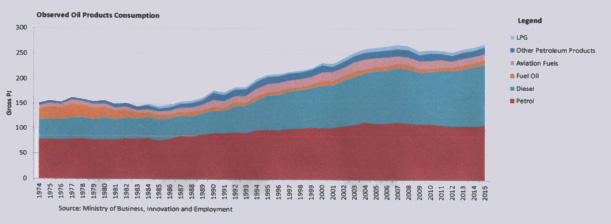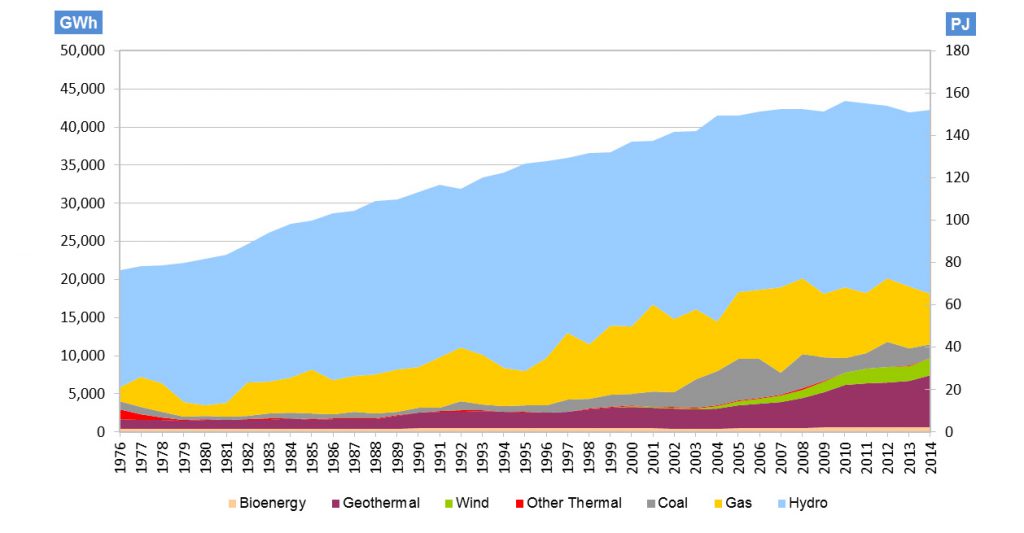New Zealand Energy Security And Climate Change
This paper sets out the case for taking early and effective action to improve New Zealand’s energy security, and doing so in a manner which minimises New Zealand’s future greenhouse gas emissions
Fossil Fuel Sources and Consumption
The estimated 2015 oil and condensate production in New Zealand is 14.7 MMbbl [1]. Assuming no major new discoveries, this is expected to reduce rapidly over the next decade. Figure 1 below shows the current forecasts for New Zealand oil and gas production [1].

Figure 1: Future NZ Oil and Gas Production Profiles
Most of the crude oil currently produced in New Zealand is exported as it is mostly ‘light, sweet’ crude whereas the Marsden Point oil refinery is geared around ‘medium, sour’ crude approximately half of which comes from the Middle East. The refinery supplies all of the country’s jet fuel, nearly 80% of diesel, around half of all petrol, and between 75 and 85% of bitumen for roading [2]. In 2012, 74% of the NZ oil market was produced by the Marsden Point Refinery and 26% was directly imported by the oil companies [3].

Figure 2: Annual Observed Oil Products Consumption in NZ by Fuel Type (1974-2015) [1]
The New Zealand Energy Strategy [4] places a lot of reliance on meeting our future oil product needs through on-shore and off-shore exploration resulting in major new discoveries.
There is currently only limited effective action to reduce demand for fossil fuels.
As a member of the International Energy Agency (IEA), New Zealand has an obligation to maintain an oil stockholding (or oil reserve) equivalent to 90 days of net imports.
This ‘strategic oil reserve’ enables IEA members to participate in the allocation of oil deliveries to balance a shortage among members during an oil supply emergency.
In New Zealand’s case, it is met through a combination of commercial inventories held by oil companies in NZ and ‘ticket’ contracts with companies in other IEA countries. Tickets are an option, in return for an annual fee, to purchase specified quantities of stock at market prices in the event of an IEA-declared oil supply emergency. New Zealand has bilateral agreements with Australia, Denmark, Japan, Netherlands and the UK which specify that the host country will not impede release of stock in the event of such an emergency.
For 2013/14, NZ secured contracts from Japan and the Netherlands totalling 155,000 tonnes [5].
The current situation:
- New Zealand imports almost all its oil products either in the form of crude oil or imported product (primarily petrol and diesel).
- Much of NZ’s 90-day oil reserve is actually held overseas through ‘ticket’ supply contracts. The rest consists of on-shore inventories held by oil companies.
- New Zealand’s domestic oil production is currently equivalent to about 30% of the total demand. As most of it is exported, it offsets a significant part of the cost of oil imports, but does little to reduce our crude oil or oil product import dependency.
- New Zealand’s current strategy is to encourage oil exploration in the hope that this will replace and ultimately substantially add to our domestic crude oil production. There is no Plan B should these not eventuate or have a significantly longer time horizon. This makes New Zealand very vulnerable to a major disruption in supply from overseas or to major damage to the Marsden Point refinery.
The following actions are required to reduce NZ’s almost total reliance on imported fossil fuels, and/or to reduce the greenhouse gas emissions. More detail on bio-fuels, natural gas and electricity production is provided below.
- Ensure that New Zealand has in place a workable and effective way of putting a realistic price on greenhouse gas emissions whatever the source, and thereby using economic signals as a means of driving down emissions.
- Facilitate and directly encourage the use of electric vehicles and vehicles using biofuels or natural gas.
- Place far higher priority on efficiently producing bio-diesel domestically, both to improve energy security and to reduce greenhouse gas emissions.
- Alter the national transport funding priorities to increase the funding for measures that reduce the demand for private vehicle travel in urban areas. These include greater funding for public transport, and measures that encourage higher vehicle occupancies, plus measures that encourage walking and cycling. They also include
Electricity
A secure and sustainable electricity supply is a vital component of New Zealand’s energy security. It is also essential that, as far as practicable, the production of the electricity be from renewable sources to minimise greenhouse gas emissions from the energy sector. Looking ahead, any substantial increase in electric car use should be supplied from renewable electricity supply sources.
In 2014, an impressive 80% of NZ’s electricity generation was from renewable energy sources. This consisted of hydro 57%, geothermal 16%, wind 5%, and bioenergy 1%. The rest was from gas (16%) and coal (4%). The NZ Energy Strategy 2011-2021 includes a target of 90% from renewable sources by 2025 “providing this does not affect security of supply”.

Figure 3: Annual Electricity Generation by Fuel Type
Over the last decade or so electricity consumption in NZ has not grown (2006 consumption 39,266 GWh versus 2015 consumption 39,488 GWh). In addition, the Tiwai Point Aluminium Smelter accounted for around 12% of NZ’s electricity demand in 2014, but its future remains uncertain [6]. This suggests that significant additional power generation may not be required for the short to medium term - unless a substantial new source of demand arises such as electric vehicles.
As demand may remain flat, achieving a target of 90% from renewable sources may require decommissioning existing coal and (fossil) gas fired power stations as well as the provision of additional renewable sources. Means of achieving this could include:
- Remove all barriers and impediments so that it is both simple and straightforward for any producer of electricity from renewable sources to feed power into the grid, regardless of its size. Set feed-in tariffs for all small or new producers using renewable sources that set the payment for power they supply to market rates.
- Research and test innovative techniques for electricity generation from renewable sources such as the use of horizontal drilling to increase geothermal energy production.
Alternative Fuels
Natural gas
As with other alternative fuels, the use of natural gas requires the development of fuel storage and infrastructure available at fuelling stations. LNG can be an attractive and efficient option for vehicles running high annual mileages, particularly for high fuel use fleet applications. CNG may not be seen as an attractive option even for cars with very high annual mileages, because of the perceived loss of engine power and the loss of luggage space (caused by the fuel tank in the boot). However, New Zealand has previous experience in the use of natural gas as a transport fuel and this would assist in its adoption. At one stage following the 1970s oil crisis about 10% of New Zealand cars (about 110,000 vehicles) were converted to CNG use, although this fell away after petrol prices fell and subsidies were removed. CNG buses currently operate in Brisbane, Sydney and Singapore. Bi-fuel vehicles using CNG and petrol are currently manufactured by Volkswagen and Volvo.
Renewable Natural Gas, also known as biogas, refers to natural gas from unconventional sources where biological processes produce biomethane from organic matter. Because it is chemically identical to fossil natural gas, yet produces far fewer GHG emissions, the blending of relatively small quantities of renewable natural gas with fossil natural gas can provide significant life cycle GHG benefits [7]. Blends of 20% RNG and 80% fossil NG have been found to yield reductions of GHG emissions by 30% or more.
Liquified Petroleum Gas (LPG)
In New Zealand LPG is currently produced from gas fields, consists of a mixture of propane (60%) and butane (40%), and is primarily used for heating and cooking. It produces significantly lower carbon emissions than petrol and broadly equivalent emissions to diesel.
Bio-Diesel and Bio-Ethanol
Z Energy in New Zealand is introducing a B5 (5%) biodiesel blend using biodiesel produced from tallow at its Wiri plant [8]. Tallow is a locally sourced by-product of the meat industry which otherwise would be shipped overseas. The plant, thought to be the first of its type in the world, will produce up to 20M litres of biodiesel initially and could increase this to 40M litres. According to Z Energy it was built without any grants, subsidies or tax incentives.
Ethanol is a renewable transportation fuel which can be blended with petrol, e.g. as E10, to help reduce imported oil requirements and greenhouse gas emissions. More than 95% of United States petrol contains up to 10% ethanol [9]. E85 (up to 85% ethanol) can be used in flex-fuel vehicles which can run on E85, petrol or any blend of the two.
Ethanol can be produced from sugar beet, although this requires use of productive agricultural land. Significant technology progress has been made in cellulose-base ethanol production which can use wood, wheat straw, fast growing grasses etc as feedstock. The Indian River biorefinery, Florida produces ethanol from vegetable waste from 170,000 residents using a combination of biomass gasification and microbial fermentation [10].
Forestry waste/wood chips and other organic sources could also be used to produce biodiesel in New Zealand. For example, lignin and cellulose could be gasified into a syngas which could then be converted to diesel or aviation fuel using either the Fischer Tropsch process or a gas fermentation process [11].
Kaingaroa Forest
Radiata pine dominates the Kaingaroa Forest in the central North Island with an area of 189,000 hectares. In 2010 the Parliamentary Commissioner for the Environment proposed that NZ focus on biodiesel as the economy is critically reliant on diesel including freight by road and bus transport. The Commissioner identified wood as an appropriate feedstock for producing drop-in biodiesel using the Fischer Tropsch process.
Potentially 6,000 dry tonnes of low-quality wood could be delivered to Kawerau which could produce about 10% of NZ’s diesel needs. The estimated production cost was $1.85 per litre.
Switch Grass
Fast growing grasses such as switch grass and miscanthus have also been identified as potential feedstocks. They can be grown on marginal land, are drought resistant, minimal or no fertiliser is needed, and there is no need to till the land for 10 years.
Conclusion
- Electric vehicles are a particularly attraction option for NZ. The government should do much more to encourage their uptake.
- Natural gas and particularly renewable natural gas are potential means of both reducing NZ’s reliance on crude oil and reducing our GHG emissions.
- Due to the potential strategic and GHG reduction benefits, New Zealand should actively support investigations into the use of forestry waste/wood chips, fast growing grasses, algae and other local sources (such as tallow), to produce bioethanol or biodiesel with a view to supporting future investment in large scale production.
References
- Energy in New Zealand 2015, Ministry of Business, Innovation and Employment.
- www.refingnz.com
- Inside Refining NZ 2012, Refining NZ
- New Zealand Energy Strategy 2011-2021: Developing our energy potential, MED, August 2011
- MED website
- MDIE Electricity Information Portal: Data table for electricity
- US Department of Energy Alternative Fuels Data Centre www.afdc.energy.gov/fuels/natural_gas.html
- http://www.z.co.nz/keeping-business-on-the-move/fuels/z-biodiesel
- ibid www.afdc.energy.gov/fuels/ethanol_blends.html
- Ethanol Producer Magazine article entitled “A Waste-Filled Proposition” dated 11 October 2013 11 International Energy Agency Technology Roadmap – Biofuels for Transport, 20 April 2011.
www.iea.org/roadmaps/
This paper has been peer reviewed by
John Blakeley, Programme Leader, Department of Civil Engineering Unitec Institute of Technology; and Dr Garth Harris, Independent Oil and Energy Consultant, formerly Secretary General at International Association for Natural Gas Vehicles.
While the reviewers have provided comment on drafts of this article, they do not necessarily endorse it in its final form. The author is solely responsible for any errors and judgements that may exist in the published article.
v.2.1 7th August, 2016

